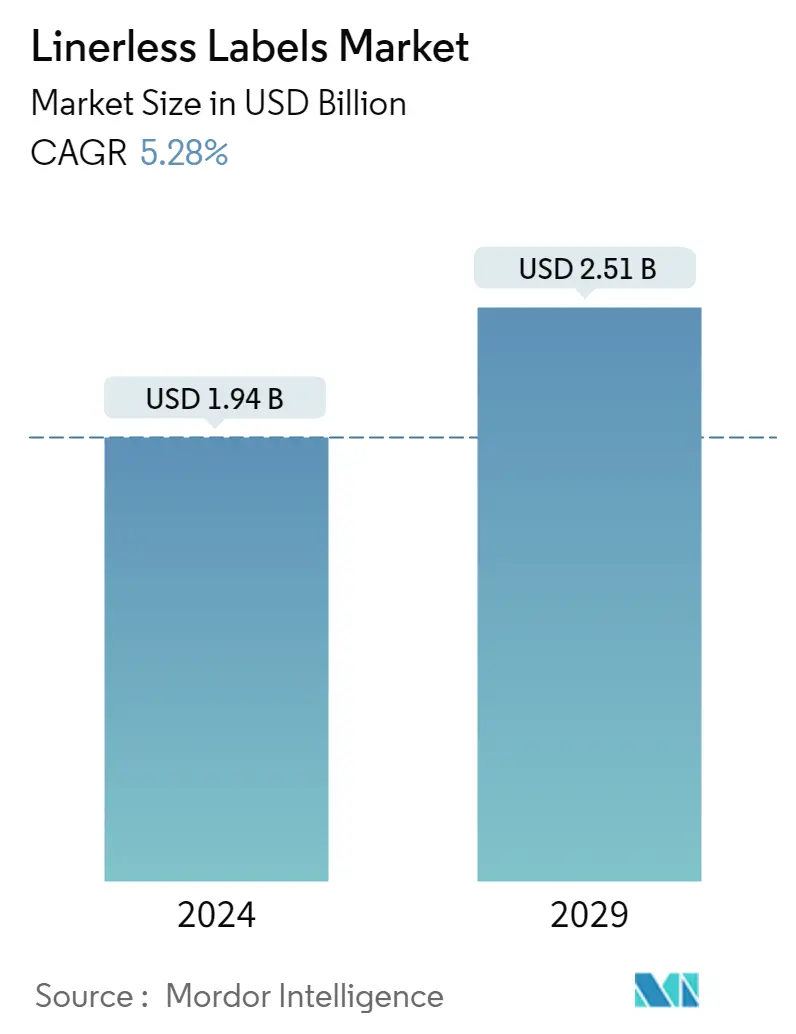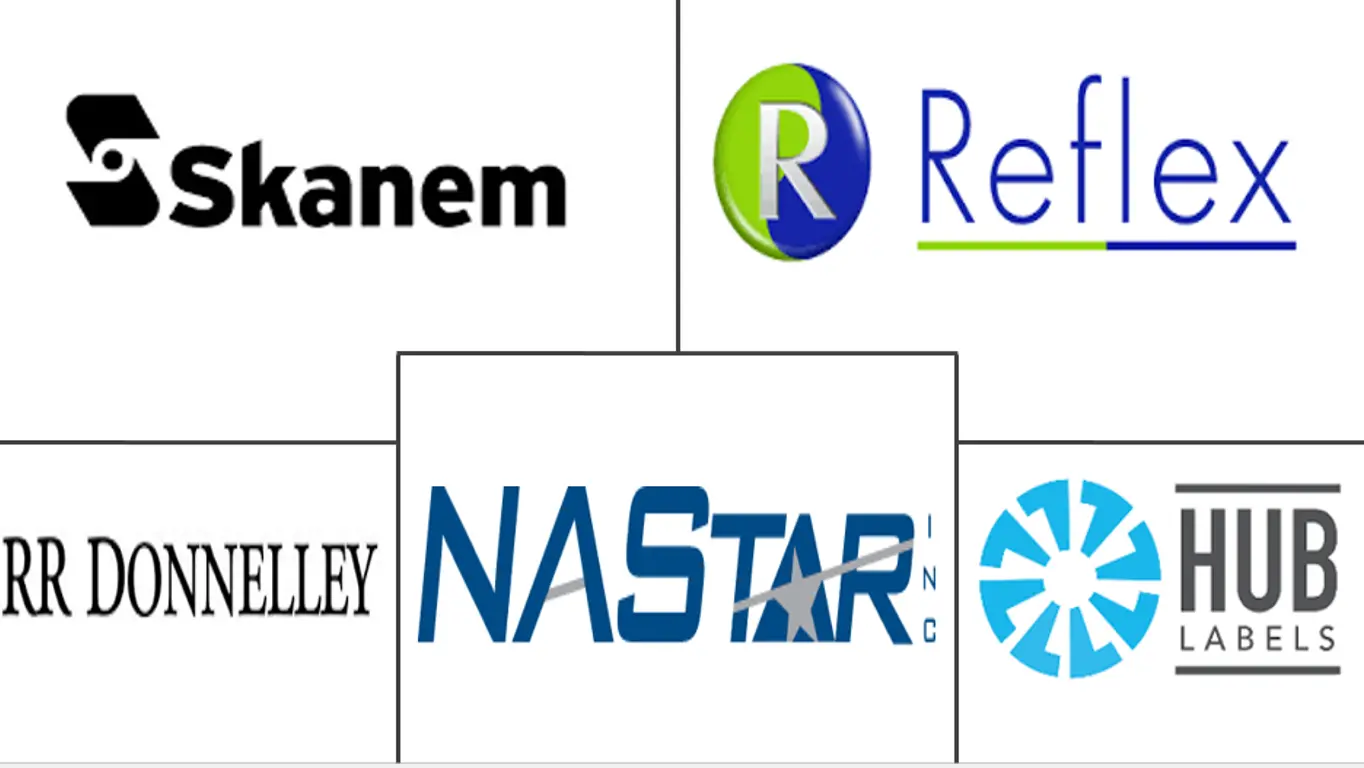Market Size of Linerless Labels Industry

| Study Period | 2019 - 2029 |
| Market Size (2024) | USD 1.94 Billion |
| Market Size (2029) | USD 2.51 Billion |
| CAGR (2024 - 2029) | 5.28 % |
| Fastest Growing Market | Asia Pacific |
| Largest Market | Asia-Pacific |
Major Players
*Disclaimer: Major Players sorted in no particular order |
Linerless Labels Market Analysis
The Linerless Labels Market size is estimated at USD 1.94 billion in 2024, and is expected to reach USD 2.51 billion by 2029, growing at a CAGR of 5.28% during the forecast period (2024-2029).
- Linerless labels have been gaining popularity because they eliminate the need for non-recyclable release liners and reduce costs. Continuous product innovation for linerless labels will sustain future market development. Linerless also offers optimum adhesive placement, wrinkle-free attachment on low-stability surfaces, and thermal transfer variable printability. Linerless labels generate minimum waste compared with pressure-sensitive labels, while the same diameter roll carries a much higher volume of linerless labels.
- Even though linerless labels provide all the benefits of self-adhesive labeling, with improved efficiencies, volume applications, and environmental advantages through their non-utilization of carrier backing paper, they are not an ideal solution for all label production as there are certain limitations.
- All printed labels are positioned on a continuous substrate web until dispensed. For separation, they must either be cut or supplied with a perforation line. The use of transparent substrates and the printing of opaque white prior to the application of the colored inks may contribute to overcoming the limitations in shape. However, this further restricts the range of use for linerless labels. Product innovation for linerless labels, including developments in face stock, adhesives, printable silicone coatings, application equipment, and converting equipment, will support further growth of the sector. The market is witnessing technological innovations owing to the research and development carried out by the players in the market. Such innovations are expected to boost the adoption of linerless labels over the forecast period.
- The packaged food and beverage industry has witnessed a significant increase in demand which is driving the need for liner-free labels and thereby aiding the growth of the market. Several industry guidelines by the government for packaged food have also shaped the demand for linerless labels. According to FDA, packaged and processed food items must have nutritional labeling that makes labeling important. The Food Safety Modernization Act mandates consumer packaged goods to be able to, at minimum, identify the immediate supplier and recipient (other than retailers to consumers) of a product to monitor the path of their products. Such regulations aid the use of linerless labels in packaged food.
- Linerless labels penetrated the market much after the traditional liner labels were made available in the market. Although linerless labels have made great strides in terms of adoption, the market still has a significant number of alternatives, including various kinds of pressure-sensitive labels, which have presented a challenge for the growth of the studied market.
- The linerless label segment has been considered stable in the COVID-19 period, owing to the increasing demand for food and pharmaceutical packaging. The COVID-19 outbreak disrupted the supply chain across various end-user industries, like food and beverage, healthcare, and industrial, among others. The pandemic created unprecedented challenges for supply chain and logistics management in the last few months. Products like canned food, toilet paper, and cleaning supplies have witnessed a significant rise in demand, while other end-use sectors have slowed dramatically.
Linerless Labels Industry Segmentation
Linerless labels are a type of pressure-sensitive labels that do not have a liner. They are made with a special release coating applied to the face of the label, which allows the labels to be wound on a roll without the adhesive sticking to the label below it. This release coating not only prevents them from sticking to each other but also creates a UV, chemical, and moisture resistant barrier.
- The Linerless Labels Market is segmented By Printing Technology (Flexographic, Gravure, and Digital), End-user Industry (Food, Beverage, Healthcare, Cosmetics, Household, Industrial, and Logistics), and Geography.
| By Printing Technology | |
| Gravure | |
| Flexography | |
| Digital | |
| Other Processes of Printing |
| By End-user Industry | |
| Food | |
| Beverage | |
| Healthcare | |
| Cosmetics | |
| Household | |
| Industrial | |
| Logistics | |
| Other End-user Industries |
| By Geography | |
| North America | |
| Europe | |
| Asia-Pacific | |
| Latin America | |
| Middle-East and Africa |
Linerless Labels Market Size Summary
The linerless labels market is experiencing a steady expansion, driven by the increasing demand for sustainable and cost-effective labeling solutions. These labels eliminate the need for non-recyclable release liners, offering environmental benefits and cost savings. The market is characterized by continuous product innovation, which is crucial for maintaining growth. Linerless labels provide advantages such as optimal adhesive placement, wrinkle-free attachment, and thermal transfer variable printability, making them suitable for various applications. Despite these benefits, linerless labels face limitations in certain production scenarios, which has led to the continued presence of alternative labeling solutions, such as pressure-sensitive labels. The market's growth is further supported by technological advancements and innovations in materials and equipment, which enhance the functionality and applicability of linerless labels.
The demand for linerless labels is particularly strong in the packaged food and beverage sectors, where regulatory requirements and consumer preferences for sustainable packaging are driving adoption. The COVID-19 pandemic highlighted the importance of efficient packaging solutions, as demand for food and pharmaceutical products surged. The Asia-Pacific region, especially countries like China and India, is witnessing significant growth due to urbanization and increased consumption of packaged foods. The market is also benefiting from rising disposable incomes and changing consumer habits, which favor convenience and quality. Competitive rivalry in the market is shaped by the presence of major players investing in research and development to enhance their product offerings and market positions.
Linerless Labels Market Size - Table of Contents
-
1. MARKET INSIGHTS
-
1.1 Market Overview
-
1.2 Industry Value Chain Analysis
-
1.3 Industry Attractiveness - Porter's Five Forces Analysis
-
1.3.1 Bargaining Power of Suppliers
-
1.3.2 Bargaining Power of Consumers
-
1.3.3 Threat of New Entrants
-
1.3.4 Threat of Substitute Products
-
1.3.5 Intensity of Competitive Rivalry
-
-
1.4 Assessment of the Impact of COVID-19 on the Industry
-
-
2. MARKET SEGMENTATION
-
2.1 By Printing Technology
-
2.1.1 Gravure
-
2.1.2 Flexography
-
2.1.3 Digital
-
2.1.4 Other Processes of Printing
-
-
2.2 By End-user Industry
-
2.2.1 Food
-
2.2.2 Beverage
-
2.2.3 Healthcare
-
2.2.4 Cosmetics
-
2.2.5 Household
-
2.2.6 Industrial
-
2.2.7 Logistics
-
2.2.8 Other End-user Industries
-
-
2.3 By Geography
-
2.3.1 North America
-
2.3.2 Europe
-
2.3.3 Asia-Pacific
-
2.3.4 Latin America
-
2.3.5 Middle-East and Africa
-
-
Linerless Labels Market Size FAQs
How big is the Linerless Labels Market?
The Linerless Labels Market size is expected to reach USD 1.94 billion in 2024 and grow at a CAGR of 5.28% to reach USD 2.51 billion by 2029.
What is the current Linerless Labels Market size?
In 2024, the Linerless Labels Market size is expected to reach USD 1.94 billion.

